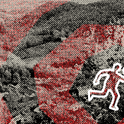About a mile outside the city of Bath, on the Kelston Road, a track leads down to a broad 19th-century house, built of the familiar, golden Bath stone. In any other town, Fairfield House would be a building of some renown. It is Grade II listed, and surrounded by neatly kept gardens. But when measured alongside Bath’s many Georgian terraces, crescents and the ruthless symmetry of the Royal Circus, it falls somewhat into the background. Bath’s tourist websites make little mention of Fairfield House. The Roman Baths, Jane Austen and the Abbey remain the headline attractions.
Even so, this Italianate villa, tucked away on the western edges of the city, is unique. It is a building with a remarkable history—so remarkable that it raises questions about Britain’s identity and our nation’s place in the world.
None of which would be obvious to a casual passer-by. On Mondays, Wednesdays and Fridays, Fairfield House is a day centre, open to Bath’s older residents, who gather in the high-ceilinged rooms to talk, eat and play dominoes.
On other days when the “elders,” as they are known, are elsewhere, people can buy tickets for guided tours. Pauline Swaby-Wallace, who is part of the Bath Ethnic Minority Senior Citizens Association and who works at the house, watches these visitors—and their reactions. “An Ethiopian gentleman came on the tour,” she told me when I visited the house in mid-December. “And he just burst into tears, just like that. Many people have cried.” Just walking into Fairfield House, she explained, was enough to set them off.
The reason is that, from 1936-1941, Fairfield House was the home of Haile Selassie, emperor of Ethiopia. It is a name that stirs deep feeling. Selassie is perhaps the dominant symbol of pan-Africanism, a man who embodied the hope that an African leader might attain prominence on the world stage. He achieved this, not least in the eyes of the hundreds of thousands of Rastafari around the world who regard him as the second coming of Christ. The musicians of the Caribbean, especially Bob Marley, peppered their songs with his name, making Haile Selassie a figure of global cultural significance far beyond the bounds of the Rastafarian religion.
“People tell me things like, ‘I’ve been trying to get here for 16 years,’” said Swaby-Wallace. “That is the emotional tie they have with this person, with their emperor, their god. And I tell them, ‘You’re here now—so don’t even look back.’”
The Italians first tried to colonise Ethiopia in the late 19th century. Rome sent troops to the Eritrean coast, from where they moved up into Ethiopian territory, but in 1896 the Italians were defeated at the Battle of Adwa by the Ethiopian army. The memory of that loss drove Mussolini to attack once more in 1935, and this second invasion forced Haile Selassie into exile in Britain. The emperor became a refugee.

Though he acquired a residence in Bath worthy of an exiled head of state, his personal circumstances were severely diminished. In the winter months, local residents used to leave free deliveries of coal on his doorstep. He was regarded with respect and a little curiosity by locals, who had certainly never had an emperor living among them before, let alone one revered as a reincarnation of Christ.
Relations with the locals became so warm that, when Selassie departed in 1941, as an act of thanks he gifted his home to the city, stipulating that it should be used for the benefit of Bath’s elderly inhabitants. He promptly re-entered the war, eventually throwing the Italians out of Ethiopia at the head of a combined British, French and Ethiopian force.
Selassie was a symbolic figure, but he was also diplomatically astute. He created an Ethiopian constitution, took Ethiopia into the UN and was behind the creation of the African Union. There is also a controversial side to his legacy. Last year in southwest London, a statue of Selassie was smashed by Ethiopians protesting his historical mistreatment of ethnic minorities. Divides in Ethiopian society are still acutely felt, and have recently broken out into armed conflict. A brutal civil war has been under way in the northern Tigray region of the country since 2020. Selassie’s postwar record in government was divisive, and Ethiopian politics has always included an undercurrent of violence. In 1974, Selassie was overthrown in a military coup. A year later he was murdered by his captors.
Despite that ignominious end, he remains one of the dominant figures in modern African history, a symbol of defiance and strength in the face of European encroachment. No other African leader has thrown out a modern invading European force, as he did. His status has developed into that of a mythical, almost godlike figure, whose life and achievements were foretold in the Book of Psalms, which prophesied that “Ethiopia shall soon stretch forth her hands unto God.” Many Rastafarians consider this a direct reference to Selassie.
Which makes Fairfield House, a day care centre for pensioners in Somerset, a site of global cultural importance. And yet, for the past 70 years, it has been almost completely ignored. Many people who’ve grown up in the city of Bath don’t even know it’s there.
“The council haven’t seen it as an important place,” said Princess Esther Sellassie Antohin, the emperor’s great-granddaughter, when I spoke to her by phone. It is a stark judgment, but walking through the house it is hard to miss the signs of water damage on the walls. The roof is not as reliable as it should be. The conservatory is rotten. A house of that size needs money for heating and repairs. It is not clear who is going to foot the bill.
None of which has affected its role as a vibrant cultural centre. Rastafarians regard the place as sacred, and they hold ceremonies in the grounds each month. Selassie’s relationship with the Rastafari was carefully managed. Despite being a devout Christian, he never objected to the Rastafarian view of him as a holy figure, but would quietly confirm that he worshiped the Christian god. In a far corner at the back of the house is an ornamental garden, created in the space where Selassie’s makeshift chapel once stood. Having been consecrated, the ground is still regarded as holy by the Ethiopian Orthodox Church, to which Selassie belonged. That ancient Christian denomination is closely associated with the Coptic Church, both of which predate European influence in Africa.
The house “has been marginalised, as a small African entity. But that’s in part our fault,” Esther Sellassie told me. The full symbolic significance of the place, as she sees it, is currently being overlooked. “We need to show that the house is much more,” she said, adding that “there are significant things about this whole history that will in some ways help redeem the ghosts of the past for the UK.”
“Heritage is only relevant if it addresses the issues of today... It can’t be stagnant and in the past.”
The emperor’s former home “is incredibly important,” said Shawn Sobers, a trustee of Fairfield House. “But it’s also incredibly buried.” Sobers, who grew up in Bath, is a professor at UWE in Bristol, the city where last year the statue of the slave trader Edward Colston was pulled down and thrown into Bristol harbour. Colston made a fortune with the Royal African Company. From the 1680s onward, he was involved in selling around 80,000 Africans into slavery. Colston’s now-empty plinth stands only 10 miles from Fairfield House. The thought that Haile Selassie lived so close to a slave trader’s monument is an arresting one.
Bristol has gone through several attempts to reckon with its past as a slaving port. However, according to Sobers, “the initiatives that the city took on—the exhibitions—have been temporary.” “The frustration was that the statue remained there, uncontextualised,” he told me. “Anything that’s tried to tell the actual deeper story has just come and gone.”
Colston’s statue was a monument to a man who didn’t deserve one, while Haile Selassie’s house is an insufficient monument to a man who does. The two seem to exist at opposite ends of a spectrum, one giving a sense of acute moral distortion, the other a more hopeful vision of Britain’s history and identity.
But they also have something in common. Both the house and the statue remind us that Britain is not an isolated country. We are not cut off, or alone. Britain has always been open to the world, for good and ill. And as more refugees try to cross the waters to find safety in these islands—as Haile Selassie himself did—and as war once again engulfs Ethiopia, it seems a fitting moment to consider which end of that spectrum better represents who we are.
Is Britain a country that welcomes and accepts difference, or one in which difference is exploited? This is the question at the root of Britain’s current cultural debates. It is the one that, in its own quiet way, Haile Selassie’s house in Bath invites us to confront.












